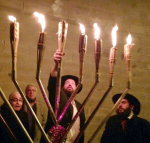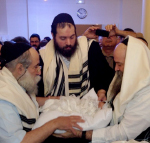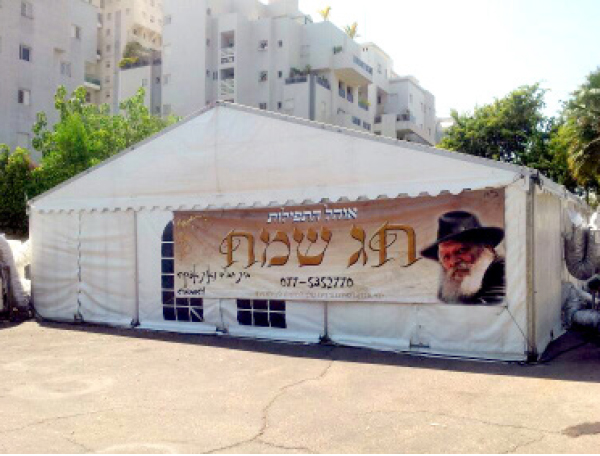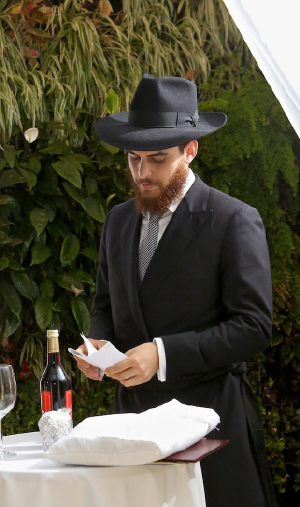We spoke with gabbaim, rabbanim and shluchim who run shuls of Chabad minyanim and heard about what unites them and what sets them apart, and about the special styles of their Chabad shuls. * PART II
SEPHARDIC WITH THE CHABAD SPIRIT
A CHABAD SHUL THAT DAVENS NUSACH SEFARD
If you visit the Ramat Eliyahu neighborhood in Rishon L’Tziyon, you can’t miss the Chabad House building that towers above. However, among the residents of the area, the Chabad House is known not just because of its impressive four story building built on a small hill in the middle of the neighborhood, but mainly because it attracts hundreds and thousands of local people. They consider this spiritual center as their headquarters for everything Jewish.
From our perspective, what makes this shul unique is its nusach. It is a Chabad House in which people daven in Nusach Sefard as per the Rebbe’s instructions.
“It was a number of years after we went on shlichus,” says R’ Chanan Kochonovsky, shliach and director of the Chabad house. “We had plans to expand and we asked the Rebbe about choosing a nusach for the shul. We had reasons this way and that way and we wanted to know whether to pick Ashkenaz, Sefard, or Chabad. The Rebbe circled the word Sefard and wrote ‘b’ruach Chabad’ (in the spirit of Chabad).”
Sefardi b’ruach Chabad. How do you do that?
“The Siddurim are Sefard Siddurim, but we include selections from the Chabad nusach and of course in the davening we sing Chabad niggunim.
“We also have another minyan in the Chabad House that is Nusach Chabad which is attended by the local Lubavitchers.”
The shul with the nusach which is “Sefardi b’ruach Chabad” has become a success. The shul has grown and now the Chabad House of Ramat Eliyahu Neve Yam is one of the largest in the country. It is located in a four story building, which has a number of auditoriums with the largest able to contain over three hundred seats.
“The big shul is full every Shabbos,” says R’ Kochonovsky. “All the seats are taken as a matter of course and people stand in the aisles every Shabbos.”
The crowd is varied and comes from every segment of Israeli society. “People love the style, the personal attention, the atmosphere; there is something special about davening at the Chabad House.”
If every Shabbos people stand in the aisles, on Yom Kippur it’s another story altogether:
“On Yom Kippur nearly 1500 people come to daven. We have four minyanim, one on each floor, and all are full. We also have another huge minyan for Kol Nidrei and N’ila in the parking lot, which is attended by over 500 people.”
How do you set up for so many people?
“On Yom Kippur nearly 1500 people come to daven. We have four minyanim, one on each floor, and all are full. We also have another huge minyan for Kol Nidrei and N’ila in the parking lot, which is attended by over 500 people.”
“It’s a major logistical operation. We have registration ahead of time so everyone knows where they sit. That prevents unpleasantness. Besides that there is the minyan in the parking lot with over 500 chairs that you don’t need to register for in advance.
“When possible, I visit each of the minyanim and try to give each one my attention, whether with a speech, guidance or just showing an interest.
“At the end of the fast we blow the shofar in relays so everyone is not heading for the exit at the same time. We first blow in the big minyan in the parking lot, then on the first floor, etc.
“It’s an impressive sight to look down, on Motzaei Yom Kippur, from the fourth floor and see all the floors and the surrounding grounds, full of men, women and children. It moves me to tears. It’s like Maamad Har Sinai.”
HUNDREDS OF PEOPLE DAVENING IN A SPORTS CENTER
AN OPEN CHABAD SHUL
The Eim HaMoshavot neighborhood in Petach Tikva is divided into two, the old and the new. In the old section you can find a nucleus of traditional families, but this is harder to find in the new section. Among the many storied buildings in the neighborhood, a Chabad House is run out of the neighborhood sports and cultural center by R’ Mordechai Garelik. It’s called the “Open Shul – Chabad.”
“The shul is in the sports center which is why it is active only on Shabbos,” says R’ Garelik. “If you come on Friday afternoon, you would not imagine that in a few hours this place will turn into a shul. We are nicknamed the ‘modular shul.’ We have all the equipment, the chairs, tables, bookshelves, bima, amud, and Aron Kodesh and it’s all on wheels. Every Erev Shabbos we set up the shul and on Motzaei Shabbos we pack it up. Just like the Mishkan.”
What is an “open” shul?
“It means it is open to the public. Everyone has a place, not just physically. Everyone is given attention and respect; there are no membership dues, and no selling of aliyos or seats. We try to make everything clear and accessible even for those who are not used to visiting a shul.
“The shul’s population is made up entirely of local residents of the neighborhood that is blessed with quite a few high-rise buildings.
“The more traditional people attend the Sephardic shuls in the area. We get those who are not officially shul-goers. They are welcomed warmly and they slowly become regulars. This is how a nice community is developing around the shul.
“On Pesach and Rosh HaShana we have communal meals in which all the worshipers eat together. Aside from that, we have farbrengens and community events throughout the year. Recently we had a Hachnasas Seifer Torah, a printing of the Tanya, and more.
“The nusach is Chabad. The Siddurim and the tunes are traditional Chabad and every Shabbos people sit down to a farbrengen after the davening.”
That’s not too much for people who up until recently did not even consider themselves traditional?
“Those who are used to their own Siddur and their own nusach will usually daven in a shul they’re used to. Those who come to us are those who have no tradition or nusach from home, or those who are disappointed with other shuls. They have no problem taking on the Chabad nusach with all the tunes. They slowly get used to it and it becomes their tradition.”
On the Yomim Nora’im the shul is packed. R’ Garelik and his wife advertise throughout the neighborhood every year and the public gladly responds to their invitation.
“Every year we add another hundred seats and there are always people left without a seat.”
R’ Garelik is helped every year by volunteers from the Chabad community in Petach Tikva.
WHY IT IS WORTH MISSING OUT ON AVINU MALKEINU
A CHABAD RABBI IN A COMMUNITY SHUL ABROAD
R’ MM Koskas is a Lubavitcher Chassid who is the rav of the large Jewish community in Noisy-Le-Grand near Paris. The shul is not officially a Chabad shul; it’s a community shul and it davens Nusach Sefard. However, since the appointment of R’ Koskas as rav of the shul, it has acquired the Chabad spirit.
Although he is a Chabad Chassid, R’ Koskas serves as chazan at all the t’fillos even on the Yomim Nora’im, as baal korei, and the baal tokeia. As the shul’s shliach tzibbur he davens the nusach of the shul “which creates conflicts for me,” he says, “but this is my shlichus and I try to deal with it.”
 Public Menorah lighting
Public Menorah lighting A bris mila in the community
A bris mila in the community
What additional dimension does a Chabad rav add to a community shul?
“Although the nusach is not that of the Arizal, a rav brings much more than nusach with him. First of all, it’s the interest and the concern for every person’s advancement in Torah and mitzvos. Then there are the drashos and shiurim that are all points from sichos of the Rebbe, and farbrengens and community events. When the rabbi is Chabad and he doesn’t hide it, then the community shul can turn into a Chabad House.”
The preparations for holidays under the leadership of R’ Koskas begins in advance. So for Tishrei, “We have a shiur every Wednesday, which from the beginning of Elul we turned into a shiur about the halachos pertaining to the Yomim Nora’im and Tishrei holidays. In order to draw people to the shiur, we had a cooking class in which people learned new recipes every week for the upcoming holiday. This class was immediately followed by the shiur.”
Since R’ Koskas took on this job, the shul has grown. The small minyan on Shabbos has turned into a large minyan and on Yom Kippur the shul is full.
I go back to the topic of different nus’chaos and asked how a Chabad Chassid can be a rav and chazan in a shul that is not his nusach.
“It’s hard,” he says candidly, “especially on Rosh HaShana and Yom Kippur. I read the piyutim to myself or fill in later if necessary but sometimes the inspiring Chabad niggun is missing. For someone used to davening on Rosh HaShana and Yom Kippur in a Chassidishe atmosphere it is hard to suddenly do something altogether different. Sometimes, I can’t restrain myself and I burst into a Chassidishe niggun in the middle of the davening. The regulars, the nucleus of mekuravim, understand me. But the rest of the visitors to the shul don’t understand what suddenly came over the rabbi.
“But, like I said, this is my shlichus. And when I feel nostalgic about what I’m missing out on, I quickly think about what is being accomplished here. I say to myself, it’s worth it.
“When I think about the families that became more involved, about the men who started putting on t’fillin, about the children who switched to proper schools, when I see families that koshered their kitchens and began observing kashrus or a group that bought mezuzos for their homes and t’fillin for their husbands for the new year, I say to myself, it is worth forgoing Avinu Malkeinu and V’Chol Maaminim or HaYom T’Amtzeinu for that.”
WHEN THE SHUL GOES OUT TO THE STREET
CHABAD SHUL IN A TENT
“A prayer tent has an advantage that even the most open and inviting shul in the world doesn’t have,” says R’ Ido Rahav, director of Chabad in Neot Afeka in Tel Aviv. “Every shul invites a person to come in. Here, it’s like the shul is being hosted in the person’s backyard.
“The fact that the shul is on the street makes it possible for the broader public, even those furthest away, to easily connect to the shul. They don’t need to walk into a formal building; they can just walk near it and peek in.”

The phenomenon of prayer tents has in recent years become one of the most successful initiatives of shluchim in Eretz Yisroel. What started as a local project has turned into a national trend.
When R’ Rahav talks about including those who are the most distant, he knows what he’s talking about. For a decade now he has been setting up a huge prayer tent in the Neot Afeka neighborhood, which is considered one of the exclusive neighborhoods in northern Tel Aviv.
The prayer tent in Neot Afeka is in addition to the shul with which it operates in tandem. They are both full.
“It is amazing to see, every year, at the end of the Yom Kippur fast, as the sun begins to set, how the bike riders along with mothers and carriages start heading toward the tent. Some of them don’t dare enter so they walk around and try to catch the sound of the shofar.
“The prayer tent is actually an open shul. The purpose of it is to make the t’fillos of the Yomim Nora’im more accessible to the public. We need to make sure that every visitor has a kippa and machzor.
“Every year there are moving stories. New people who came, people who found the t’fillos touching and who come to thank me.”
The tent presents logistical problems:
“The baal t’filla must have a powerful voice so he can be heard throughout the tent. It is also important to arrange for a staff of volunteers who will welcome those who come and who will support the chazan in the singing and harmonizing during the davening.”
WHEN THE SATMAR CHASSID ENVIED THE PRAYER OF THE BACKPACKER
 CHABAD SHUL FOR TOURISTS
CHABAD SHUL FOR TOURISTS
“We anticipate 100-200 tourists for Rosh HaShana,” says R’ Caplin, director of the Chabad House for tourists in Cozumel, Mexico. “We do not announce where the meals will take place. That way, they show up for t’fillos and afterward, everyone goes together for the meal.”
We could not end this survey of shuls and Chabad minyanim around the world without examining the shuls for tourists. In recent years, Chabad Houses for tourists have become an inseparable part of life for countless Israeli youth. What used to be a surprising experience, to suddenly meet a smiling Chabadnik in the middle of nowhere, has become a standard form of shlichus. There are even those, mainly religious tourists, who plan their itinerary based on Chabad Houses in the area.
These Chabad houses are scattered throughout the Far East, Central and South America, in the Philippines, and lately even in Ethiopia. Out of all these, we chose to focus on one of the biggest in the world, if not the biggest, the Chabad House in Cozumel.
“It’s not just here; it’s a chain of Chabad Houses geared to the tourist trade throughout Central America,” R’ Caplin is quick to correct. “We figured out that in all the Chabad Houses for tourists, over 10,000 of them will pass through during Tishrei; it’s incredible.”
R’ Caplin recently returned to Cozumel and joined his friend R’ Shlomi Peleg. “On Yom Kippur we can get 300 people. We try to make the t’fillos experiential. We supply machzorim, kippos, and even prepared pages with stories and explanations about the holiday for those who find it hard to concentrate on the davening.”
What is Yom Kippur together with hundreds of Israeli tourists like?
“Incredible. It’s an altogether different kind of experience. Even for us shluchim it’s incredible, every time, to see Israeli youth treating t’filla, this holy day, with respect; sometimes even more than us.
“Religious people approach us, Israelis or sometimes even Satmar Chassidim who come here a lot, and they tell us this is the first Rosh HaShana of their lives in which they felt so uplifted.
“They see the tourists take the machzor with all seriousness. They read from it word by word with concentration and believe with complete faith that in the merit of the prayers Hashem will inscribe them for a good, sweet year.
“It is less about who the chazan was and how he did, how much and where he was overcome with cantorial fervor, than conversations about the nature of the day, about the mitzvos that are done at this time and what they signify. That is the talk in shul. The chevra there really connect to G-d. They all sing together enthusiastically and it’s incredible!”